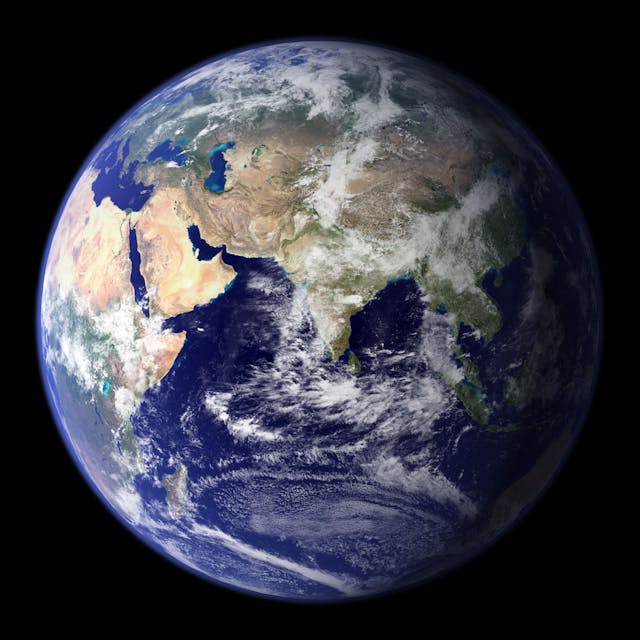
What shape is the Earth? The Earth is not a perfect sphere, it is an irregularly shaped ellipsoid. Another word for ellipsoid that is often used is oblate spheroid.
An ellipsoid, or an oblate spheroid, is a sphere that is slightly wider along one of its axes than another. If you are blowing glass and you blow a bubble and then spin it, you will get an ellipsoid shape. In fact, people used to use that method to make early plate glass. When a sphere is slightly compressed on one axis and slightly wider on another axis, it is an ellipsoid or an oblate spheroid. Our Earth is an ellipsoid because it is not solid and it spins very fast.
Earth spins at a very high speed. It rotates at about 1,600 km/h. Earth is not the fastest planet by a long way. Jupiter rotates at about 43,000 km/h. In fact, Jupiter spins so fast that its atmosphere cannot keep up and it has a lag. When something spins as fast as Jupiter or Earth and isn’t completely solid, centrifugal force can change its shape. Because the Earth is spinning very quickly, all of the rocks, water, animals, and particles on it want to keep going in a straight line. This is the centrifugal force. Fortunately for all of us, gravity keeps us on the surface. However, along the equator, gravity is not strong enough to keep the surface of the planet completely flat and it bulges out ever so slightly. It is not a huge bulge. The diameter of the Earth from pole to pole is 12,714 km and the diameter at the equator is 12,756 km. The spin of the Earth pulls the equator out by about 40 km, which is not a lot when you think about the size of the Earth. Jupiter has a difference of about 4,000 km, which is also not a lot when you think about its size. If the Earth was a completely solid ball, it would probably not have a difference at the poles and the equator because it would not be elastic enough. However, between the Earth’s solid core and the mantle, the Earth is soft and elastic, which allows it to stretch as it spins.
The centrifugal force is not the only reason that Earth is not a perfect sphere. Another reason is the distribution of the land. The parts of the Earth’s crust with the continents weigh more than the parts that have only sea. This weight difference makes the weight distribution on the Earth uneven and that can have an effect on how much the Earth bulges. Heavier continents press down more on the mantle than the lighter seabed. The topography of those continents will have a huge impact as well. Mountains are much heavier than flat land and the more mountains a continent has, the more it will press down. Ice ages can also have an effect. When Earth is in an ice age, the heavy ice on the land pushes the land down even more. When the ice melts, the land slowly rebounds and rises up again.
We must also take the moon into consideration as well. The moon exerts a significant pull on the Earth and squashes the Earth. The moon obviously pulls on Earth’s water and causes the tides, but it also pulls on the mantle of the Earth and deforms it slightly. This deformation passes when the moon Earth rotates away from the moon, but it is a factor in the shape of the Earth.
How do scientists know the shape of the Earth? There are three ways that it is generally measured. The first way is with thousands of GPS receivers. These are placed on the surface of the Earth in many locations and they constantly communicate with GPS satellites. They can triangulate their position and they can measure any change in their altitude down to the millimeter. The second way is by firing lasers at satellites in space. The position of the satellite and the time it takes for the laser to travel are known, so any difference in the time it takes the laser to arrive allows scientists to calculate a change in the altitude of the source of the laser. A third way is something called Very-long-baseline interferometry. A series of base stations around the world receive a signal from an astronomical radio source, such as a quasar. The difference in times of when this signal was received by the different stations allows scientists to calculate their position and to work out if they have moved as the surface of the Earth moves. And this is what I learned today.
Sources
https://oceanservice.noaa.gov/facts/earth-round.html
https://www.iflscience.com/the-earth-isnt-perfectly-round-heres-why-71838
https://www.scientificamerican.com/article/earth-is-not-round
https://en.wikipedia.org/wiki/Very-long-baseline_interferometry
https://www.sciencefocus.com/planet-earth/why-isnt-the-earth-a-perfect-sphere
https://coolcosmos.ipac.caltech.edu/ask/200-Which-planet-spins-the-fastest-
https://www.livescience.com/52488-centrifugal-centripetal-forces.html
https://physics.stackexchange.com/questions/109500/does-centrifugal-force-exist
